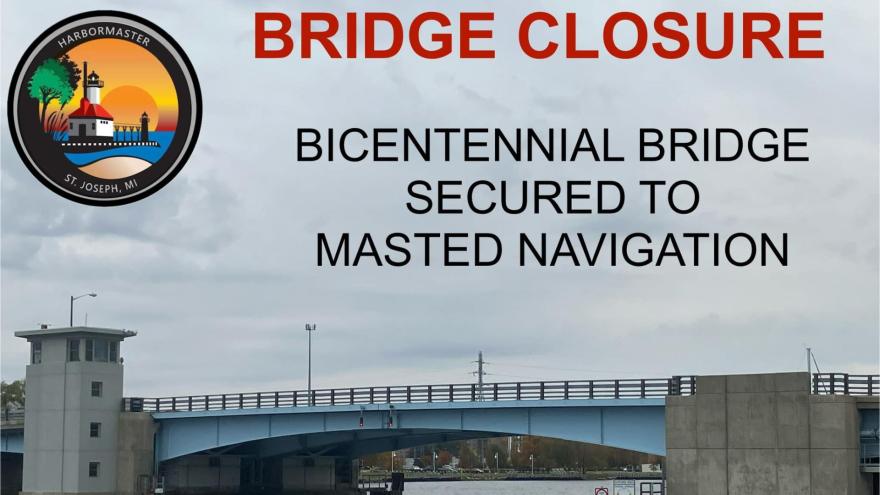Berrien County's Bicentennial Bridge reopened after repairs
See Also
"MDOT and a contracted crew successfully replaced a failed hydraulic cylinder which had rendered the bridge unable to lift safely," Moran said. "The bridge is now repaired, has been tested, and is operating normally per MDOT."
"I want to thank MDOT and their contractors for their efforts, and I want to thank all boaters, marinas and harbor users for their patience and understanding during the repair," Moran said.
From Harbormaster Mike Moran:
The Bicentennial Bridge suffered a failure in a hydraulic cylinder that left it unable to open. Let’s take a look at what happened and how it was repaired.
To start with, remember that the bridge was built in 1976 during the Nation’s Bicentennial Celebrations, earning it the name “Twin Cities Bicentennial Bridge”. The bridge has been overhauled many times since then, but it is still nearly 50 years old.
The bridge is a rolling bascule-type bridge. It relies on hydraulic cylinders to raise and lower the moveable sections or “leafs” of the bridge. In March, one of these cylinders failed as the bridge was being lowered. Fortunately, it was during a routine inspection before boating season got heavily underway. While this failure could have occurred at any time, it occurred during this inspection when the bridge wasn’t being heavily used.
In a stroke of incredible foresight, over 20 years ago MDOT had a replacement cylinder fabricated during a project and stockpiled in a warehouse. Once it was apparent the spare cylinder was needed, it was pulled from the warehouse and sent for testing.
After confirming that decades of storage hadn’t caused any issues and the cylinder was usable, a contract was signed to replace the cylinder.
Trojan Development Company out of Oxford, Mi, was hired to swap the cylinders, and the replacement was trucked in, as were the tools and supplies. These were all craned aboard a barge provided by Viking Marine Construction, and the barge was positioned in place under the bridge.
The next step was to remove the old cylinder. This was no easy feat, as the cylinders weigh over 4,700 pounds each, but it was completed safely. The new cylinder was installed and it was filled with 60 gallons of hydraulic fluid. The tools and supplies were gathered up, and the barge was removed.
I was told the removed cylinder will be sent for extensive repair and rebuilding and that it will then become the spare.
After much testing and inspection, the bridge was deemed operational. And of course, the contract crew and the MDOT employees involved were given “St. Joughnuts” to thank them for their efforts.
I had to wait for the official announcement from MDOT that they were releasing the bridge. As I received that, I also received a notification through the Coast Guard’s Bridge Office at the 9th District Headquarters in Cleveland confirming the bridge was cleared for normal operation.
And with that, it was time to notify the officials at the City that I report to, and then to inform the public and media with a formal press release. I will say that it felt good to give everyone good news about the bridge.




